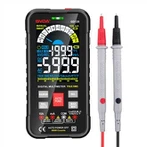Should I use on-off mode or resistance mode when measuring short circuits and open circuits with a multimeter?
The on-off gear is also called the buzzer gear. In this gear, if the actual resistance value of the line under test is lower than a certain value (I forget the specific number, it is explained in detail in the manual), the buzzer will sound.
Taking a digital multimeter as an example, the buzzer mode seems to be able to measure resistance up to 2,000 ohms.
For example, if you measure a pure line (such as a 100-meter roll of wire), it will buzz if the wire is not broken.
Another example is a section of line. There may be some resistive components (such as coils, motor windings) connected in series in the middle, or the line may be very long, with many connections, etc. When measuring at this level, it may not beep, but it will display a value. The value at this time is the resistance of this section of the line, but it cannot fully indicate that this section of the line is open.
For example: you randomly select a good AC contactor coil and use the buzzer setting to measure both ends of the coil. It will not beep, but it will display a value (assumed to be 758); you then use the 2 kiloohm resistance setting to test again. The value obtained is still 758, which means the resistance of this coil is 758 ohms. At this time you cannot say that the coil is open circuit. If the coil is open, the reading will be zero and there will be no chirp.
If there is no chirping or indication, strictly speaking, it still does not mean that this line is open. Because as mentioned above, this gear can only measure a maximum resistance of 2 kiloohms. Therefore, it is possible that the resistance of this line is higher than 2,000 ohms. At this time, you can change to a higher resistance level and test again.
In practice, there is generally no need to go into such detail. For example, if a 100-meter roll of wire is not broken, if it does not beep when measured with the buzzer, it can basically be judged that the roll of wire is not as good as It's done.
Another example is that you know that what you want to measure is the winding of the motor, and you have a good idea of the number in mind before measuring. When measuring it in the buzzer mode, it does not show the number or beep. To ensure accuracy, you should change to a larger gear and measure again.
Anyway, I personally think that what we should pay attention to is: 1. The buzzer mode can only measure resistance below 2 kΩ; 2. It will only beep when the actual resistance value is lower than the set value. Keep this in mind and then predict the accuracy of the predicted results based on actual conditions. In other words, predict which gear measurement is most suitable based on the actual situation.
To be honest, I am also used to using the buzzer mode to test continuity. And I use a digital meter. The explanation above is also based on the digital meter. I rarely use mechanical watches, which means I don't know much about it.






